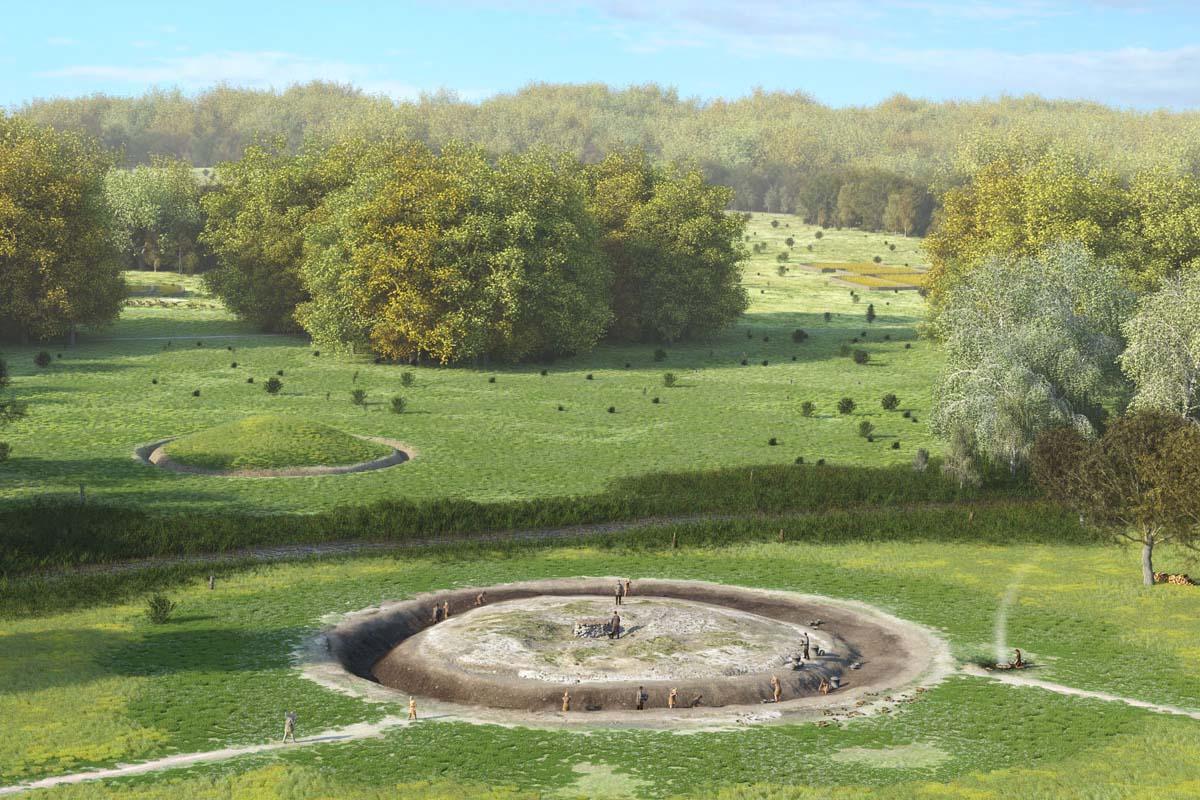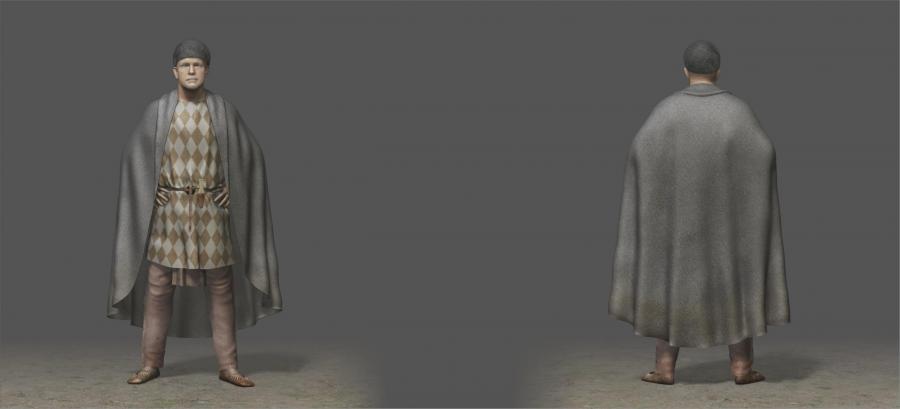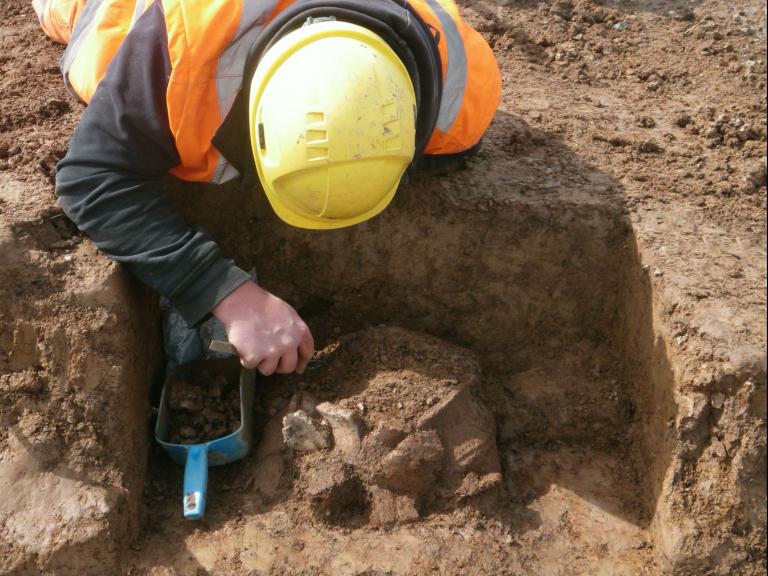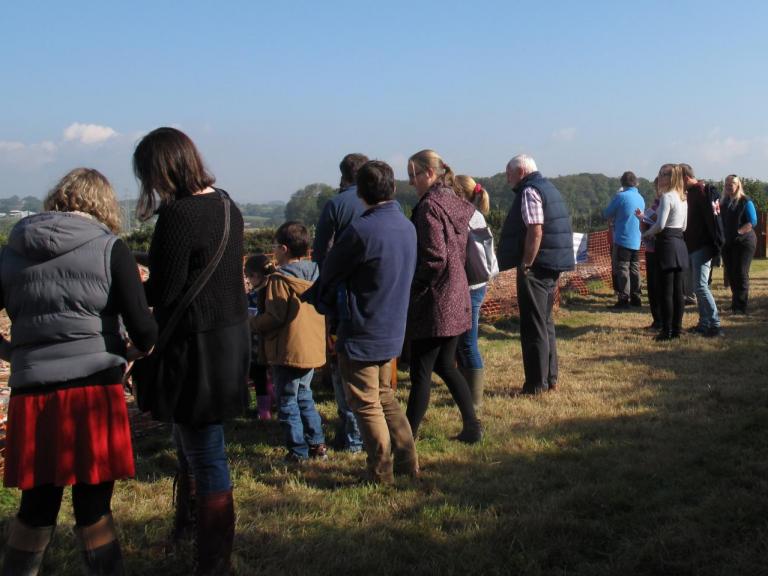Exciting discoveries during our excavations at Sherford, Plymouth have provided the wonderful opportunity to bring to life the evidence through photogrammetry and 3D reconstructions.
Excavations during 2016 gave us the rare opportunity to excavate two extant Early Bronze Age barrows located at the bottom of a shallow valley, separated by a small watercourse. Our work across the whole area had shown that the monuments had been a focal point in the landscape for several millennia, with multiple Bronze Age cremation burials and Romano-British inhumations all located within sight of the barrows.
The team excavating the northern of the two barrows made a particularly exciting discovery at the centre. What initially appeared to be a pile of limestone rubble was revealed to be a large and significant mortuary structure complete with orthostats (upright stones) which were purely decorative in function. The feature was completely devoid of any artefacts, although once the stones were removed piece by piece, a remarkable discovery was made. Located directly beneath the western end of the structure, the team found a complete and inverted Early Bronze Age Food Vessel. The vessel was excavated in the lab revealing the cremated remains of a middle-aged male, while fragments of a singular copper-alloy knife were also recovered from the base of the undecorated vessel. Green ‘spot’ staining was also observed on bone fragments recovered from the pot in the area of the waist, which suggests that the blade was worn on the hip prior to cremation.
The excavation of the southern-most barrow revealed that this monument was also constructed to commemorate a single person, this time a sub-adult female. Radiocarbon dating has subsequently shown us that both barrows were broadly contemporary. Although we cannot tell if the individuals were related (as DNA analysis is not yet possible on cremated bone), it is tantalising to consider that they were possibly immediate family. Whoever they were, they were clearly significant enough in their communities to be commemorated in such a spectacular way.
The excavation of the barrows, and the discovery of limestone mortuary structure and inverted Food Vessel, has provided the opportunity to interpret the evidence in new and exciting ways.
Graphics Officer Will Foster explains how he has used new techniques to bring the evidence to life:
“The starting point for our series of reconstructions was with the small twisted fragment of copper alloy blade. Using traditional finds drawing techniques, I produced an initial drawing of the blade which was then digitally modelled in 3DS Max, a powerful piece of software used in 3D visualisation.
No evidence of the handle remained although we had two rivets (from which a handle thickness could be extrapolated). The handle could have been made from a variety of materials but the decision was made to represent one produced from wood (evidence for a bone or horn handle might have survived in the cremated remains) and roughly proportional to the length of the blade. There is scant evidence for handles on this type of Early Bronze Age flat riveted knife though marks on the blade can sometimes help in describing their form. Ultimately, the shape chosen was based on the types that have survived though there could have been a separate pommel made from bone or even an exotic material such as amber.
The handle, like the blade was digitally modelled as a separate part along with the rivets. Partly this aids in texture mapping the different elements, but we also intended on producing a 3d print of the object”.
“Having built the knife, I now turned to producing an interpretation of the male found in the northern barrow. We knew his rough age and height and the location of the knife he carried but beyond that, very little! However, he was likely of some significant importance having received such a burial which helped shaped the approach to visualising not only his look, but pose as well.
Evidence for clothing, especially in Britain, is limited so I looked at a number of different European sources for inspiration. The Danish Mound People were a particularly useful source of information especially for the cloak and hat. The hide leggings and loincloth were based on the earlier technology of Otzi ‘the iceman’. He’s shown wearing a sleeveless tunic with a diamond pattern inspired by the styles of geometric patterns appearing on contemporary pottery. The aim was to produce a striking garment to lend weight to the importance of this individual. The knife was added in a simple leather sheath attached to a belt secured in a belt loop.
As we don’t know what the Barrow man looked like we chose to base his face on that of Sherford’s Site Director, Matt Kendall. A 3D model of his head was produced using photogrammetry and built into the rest of the digitally sculpted model, suitably posed, I would hope, to give a sense of the importance of this individual”.
Whoever the Early Bronze Age man was, he was clearly revered enough in his community to be treated in such a way after his death. Being a person of importance, he clearly held some standing and possibly a wealthy figure. The small knife he was cremated with is an indicator of status – perhaps he was a trader in tin and copper which were being mined in Devon and Cornwall at the time. The small bronze knife or dagger may have had a number of uses; it could have been seen as an exotic weapon; or something more mundane such as an implement for skinning animals. The knife is likely to have been cast in one piece and the handle, destroyed in the pyre, was likely to have been manufactured from wood or bone. Two copper-alloy rivets were discovered which would have held the handle to the blade.
The evidence has allowed us to try to visualise the Sherford landscape over 4000 years ago. Through our excavation and analysis, we now know more of the landscape’s appearance during the Early Bronze Age. We also know that, through radiocarbon dating, the two barrows were largely contemporary. It is our interpretation that the limestone mortuary structure found at the centre of one of the barrows, would have been standing in the landscape for some time before being covered by the barrow mound. In light of this we have been able to digitally reconstruct an aspect of the Sherford prehistoric landscape.

Will explains:
“The topography of the reconstruction you see here is based on LiDAR data of the area, cleaned up to remove existing field boundaries and woodland. We have evidence for a broad palaeochannel between the barrows (as opposed to the small stream present today). Amongst the reeds on the river bank, various stumps of trees can be seen, these would of been cleared to preserve an uninterrupted view of the barrows and surrounding landscape.
The foreground barrow is shown under construction, with the soil from the surrounding ditch being built up around the mortuary structure. Whilst the majority of the people work within the ditches others can be seen preparing food over a fire and collecting wood as part of this joint effort to build a monument to an important member of their community.
The landscape shows evidence of the clearance of the surrounding forest with a group of sheep being herded and fenced enclosures with crops”.
We intend to create more visual interpretations and reconstructions to bring the evidence recovered at Sherford to life, both through visual interpretations as well as 3D printing, and in so doing help people understand a little more about their own landscape.


